Breathtaking views you shouldn't miss in western Sichuan
Writer: Chen Xiaochun | Editor: Stephanie Yang | From: | Updated: 2020-08-10
Recently a travel review about western Sichuan was published on Mafengwo, a leading Chinese independent online travel platform, and attracted thousands of views online. What endows this place with such an attractive magic?
Basically all you can think of and even cannot think of: its lofty snow mountains like that of the Himalaya, its crystal-clear lakes which appear in Jiuzhaigou Valley, its splendid views which will remind you of the Dolomites in Italy, its extraterrestrial surface which may give an illusion of entering “Interstellar,” and its daily experience of watching the golden sunlight shining on the snow mountain… The stunning views along the way are sure to leave you in awe of the power of nature. Let’s hit the road and embrace this splendid place.
Cuopu Valley
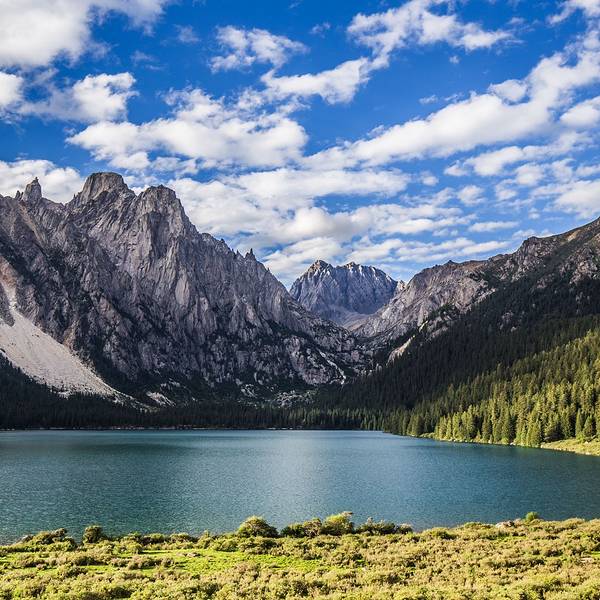
Cuopu Valley, located in the west of Ganzi Tibetan Autonomous Prefecture in Southwest China’s Sichuan Province, boasts of a brilliant condensation of mountains and rivers. It’s not completely developed yet, thus is still in its natural state.
The pristine land combines natural and cultural views including peaks, glaciers, virgin forest, lakes, valleys, waterfalls, springs, grasslands and Tibetan temples.
Approaching Cuopu Valley, you will see many mountains rising up in front of you, giving you an illusion of visiting the Dolomites in Italy. Enter the mountain forest and track up the trail, and you will be embraced by a jade-green lake, which will remind you of Sichuan’s own Jiuzhaigou Valley.
Looking in another direction lies the Cuopu Lake. Standing alongside the lake you will feel as if you were traveling to Shangri-La. Embraced by forests on both sides and with Snow Mountain as the backdrop, the green and crystal-clear lake water shines under the sun.
Moshi Park
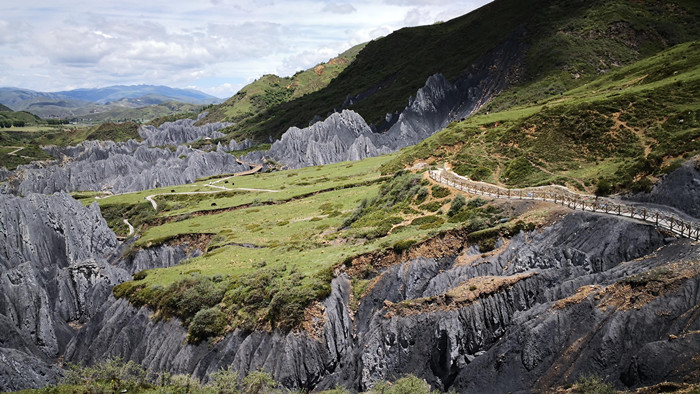
Located at the Tourist Center of Bamei County and a geological science center, Moshi Park is a national 4A level attraction featuring unique geographical landforms. It is China’s only plateau stone forest landscape. It has a mylonite forest formed by the crushing, grinding and shearing of rocks in the fracture zone of the part of Xianshui River in Daofu County that took place during the neotectonic movement in the Quaternary period.
Affected by air humidity, the color of the mylonite forest changes according to the weather. During the wet season, the stone forest turns dark black. Such a metamorphic stone forest is extremely rare in the world.
Looked at from a distance, the stone forests appear to be mountains. If you stand on top of the mountain and look down at it, it may give you an illusion of visiting an extraterrestrial planet.
Siguniang Mountain
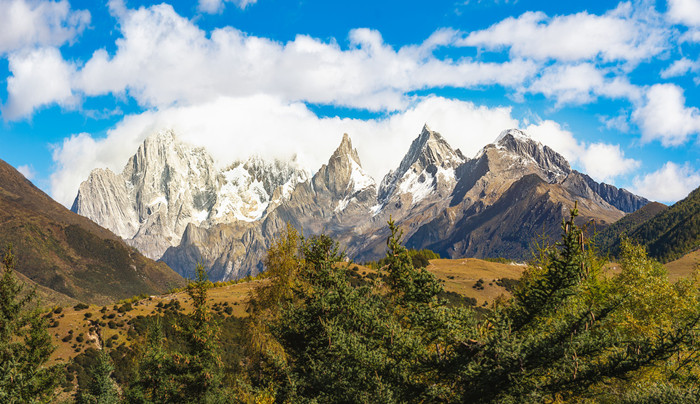
Siguniang Mountain is located in Xiaojin County, Aba Tibetan and Qiang Autonomous Prefecture, Sichuan Province. It consists of four peaks, namely Daguniang Peak (1st Peak), Erguniang Peak (2nd Peak), Sanguniang Peak (3rd Peak) and Yaomei Peak (4th Peak). Erguniang Peak, enjoying an altitude of 6,250 meters, is the second-highest peak in Sichuan.
Famous for its beautiful scenery, Siguniang Mountain is reputed to be the “Oriental Alps.” Throughout the year, the four peaks are covered with white snow, looking like four girls covered with white veils standing between Changping Valley and Haizi Valley. White Tibetan towers, colorful prayer flags and Mani stone piles can be seen everywhere in the tourist resort.
Once you come to Siguniang Mountain, don’t forget to check out Shuangqiao Valley. The name “Shuangqiao” means two bridges for this scenic area has two bridges; one is made from willow trees and the other is made of redwood.
It’s a well-developed tourist site. There are sightseeing buses that can take you around to check out the area. Sitting inside the bus, you will see the views outside keep changing as the altitude increases. Walking deep into the valley, you will find that the surrounding area is covered with rich vegetation and in the distance stand snow-capped mountains.
Daocheng Yading
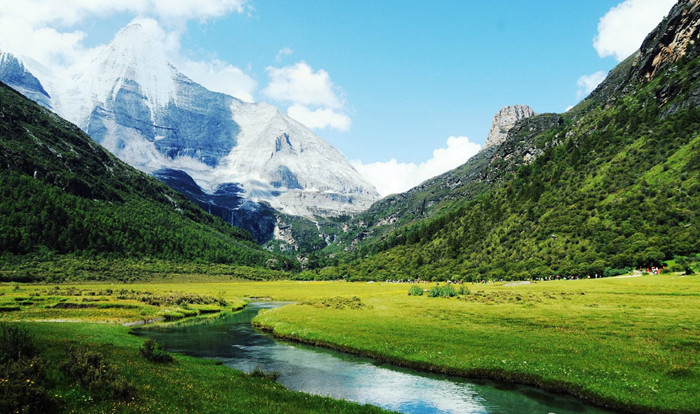
Daocheng Yading, the harmonious utopian land of snow-capped mountains, awe inspiring glaciers, steep cliffs, magnificent canyons, vibrant virgin forests, grassy marshlands, vast pastures, crystal clear lakes, dense woods and pure air, is reputed to be the last pure land on earth.
Located at an elevation of 3,800 meters, Yading is home to three holy mountains and three lakes, namely Jambeyang (Yangmaiyong), Chanadorje (Xianuoduoji) and Chenresig (Xiannairi) and Pearl Lake (Zuomalacuo Lake), Five-color Lake, and Milk Lake.
The three holy mountains are all covered by snow and Xiannairi, the highest of the three, boasts a height of 6,032 meters. Yangmaiyong and Xianuoduoji enjoy the same altitude of 5,958 meters above sea level.
Hiking to see Five-color Lake and Milk Lake is not an easy job but definitely worth the effort. Five-color Lake, at 4,600 meters above sea level, is located between the Xiannairi and Yangmaiyong snow-capped mountains. The name comes from the appearance of five different bright colors in the lake caused by the refraction of the sunlight in the water.
The crystal blue water of Milk Lake, at an elevation of 4,500 meters, is shaped like a water droplet, and is surrounded by a snow-covered mountain.
Pearl Lake is an ideal place for taking pictures of Mount Xiannairi. The banks of Pearl Lake bloom with life in the warmer months with large fields of Indian Azelea swarming around the bank of the lake as gentle waves lap against its shore. In autumn the lakeside turns a rusted yellow with all the plants preparing for winter. This lake is truly a magical place.
Sea of clouds at Zheduo Mountain
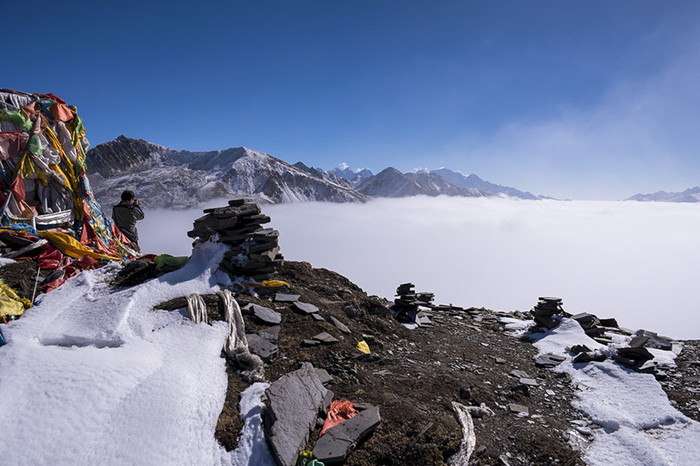
Located in Garze Tibetan Autonomous Prefecture, Southwest China’s Sichuan Province, Zheduo Mountain is known as the first pass of the Kamba Area. The mountain is at an elevation of 4,298 meters. Zheduo means “winding” in the Tibetan dialect and means “a lot of winds” in Chinese, hence the name.
Zheduo Mountain is not only the watershed of the Dadu River and Yalong River drainage basin, but is also the boundary line between Tibetan and Han cultures.
Due to its special geographical environment, standing at the peak of Zheduo Mountain you can always appreciate a sea of clouds.
To the east of the mountain is a mountainous area while to the west is the Tibetan Plateau, the real Tibetan area. As a must-pass place on National Highway 318, the Sichuan-Tibet Road, Zheduo Mountain is also called the first pass to the Tibetan area. In the past, people did not know how dangerous it was to drive on the Sichuan-Tibet Road until they got to the stretch on Zheduo Mountain.
At the top of the mountain, you can look around at the snow-capped Mount Gongga, also known as Minya Konka, the highest mountain in Sichuan Province. With the sea of mists and clouds under your feet and looking at sunlight shadowing through white clouds on a snowy road, you will definitely be stunned by the grandeur of nature.
Litang Monastery
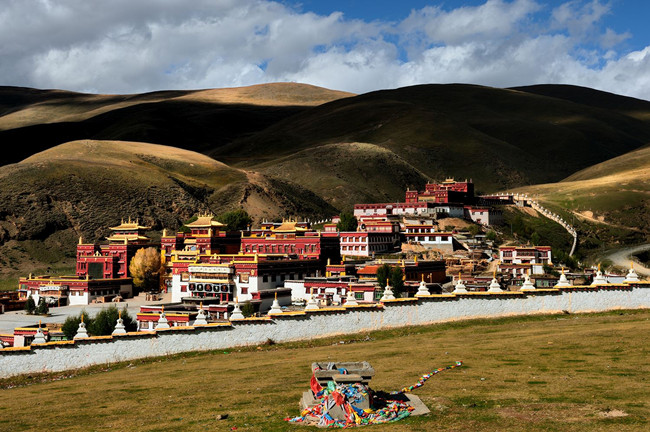
The Litang Monastery is also known as Ganden Thubchen Choekhorling Monastery, meaning Happy Buddha Dharma, symbolizing the way one’s moral dharma is always transforming and at the same time one’s true essence holds forever. Lying at the north of Litang town, the Litang Monastery was built by the Dalai Lama III in 1580. The monastery is the biggest Gelukpa monastery in the Kham region which makes it important to Tibetan Buddhists.
Before reaching the temple, from the distance you can see the golden roof top of the temple. Golden roof tops form an important part of Tibetan palaces, temples, and pagodas. It’s a unique architectural ornament of Tibetan architecture.
With its palatial architecture, wide variety of multi-piled structures, various statues, exquisite sculptures and an extensive literature collection, the monastery has become a treasure trove of modern Tibetan religion, culture and art. The monastery covers an area of 500 mu (333,000 sqm).
At the highest point of the monastery there is parking space. You can reach it driving to the temple and can enjoy the panorama of the whole town along the way.
Xingyicuo Lake
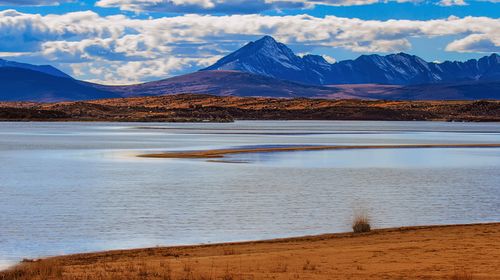
More than 100 lakes are spread around the Daocheng Yading scenic area, and Xingyicuo Lake seems to stand apart from the rest of them.
Drive along Provincial Highway 217 and turn off onto Xianggelila Sheng Road, keep driving and then you will come to a frozen lake, which is Xing-yicuo Lake.
The name Xingyicuo may sound unfamiliar to most people. But in the area of Haizi Mountain, most people know about it. There are thousands of lakes of different sizes around Haizi Mountain. Xingyicuo Lake is the biggest one which is regarded as a sacred lake by the local Tibetan people.
The altitude in this area is more than 4,000 meters above sea level.